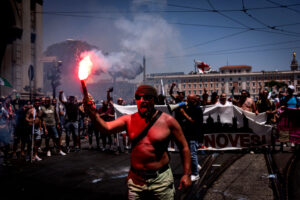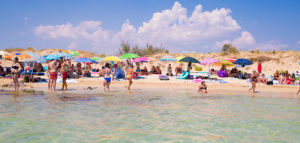There has been talk of building a bridge to link Sicily to the Italian mainland for so many decades that the project has become a synonym for a pipe dream and a source of infinite satire. “There will be a bridge over the straits,” says one character dreamily in the comedy series Boris. “Yes, it will resolve all our problems,” his girlfriend replies, “it will defeat the mafias.”
Ferdinand II of the Two Sicilies pondered the idea of a bridge as long ago as 1840. More recently, Silvio Berlusconi emerged as its greatest champion. His building plans were twice thwarted by political rivals who deemed it an absurd vanity project — but his vision still inspires devotion in Italian politics today. The Strait of Messina Bridge has come to symbolise a powerful and modern Italy. In a country fretting that its days of breath-taking building are over, the bridge is seen as sign that contemporary leaders can match not just the grandeur of ancient Roman viaducts and Renaissance churches, but also Mussolini’s creation of entirely new suburbs (a project later adopted by Berlusconi).
The politics of the bridge are intriguing: Giorgia Meloni’s government has recently augmented fiscal autonomy for the regions, which will almost certainly benefit the north more than the south. The bridge promises the opposite: it’s a nationalist symbol uniting the country and showing the south that Rome cares. The EU likes the idea because it would complete its Scandinavian-Mediterranean corridor. The transport minister and leader of the Right-wing Lega party, Matteo Salvini, has also gone all-in. In five years, as Meloni’s star has risen, Salvini’s popularity has crashed. And so despite opposing the bridge until 2016, he has now bet the entirety of his dwindling political capital on its completion.
“This project is very elevated in the public imagination,” says Guido Signorino of the Invece del Ponte group. “It’s like the pyramids, and Salvini wants to enter the history books as the visionary who made it happen.” The man who has journeyed from communist to neo-fascist, from secessionist to nationalist, now appears to see himself as Italy’s Pharaoh.
Architects envision a bridge 3.6 kilometres long, bookended by two main towers higher than the Eiffel Tower. With three vehicle lanes in each direction plus train tracks down the middle, 6,000 vehicles could pass over per hour and 200 trains per day. This won’t, of course, come cheap. According to the Italian Treasury, €1.2 billion has been spent on feasibility studies since 1965. The estimated cost of building the bridge has increased exponentially: in 2006 it was calculated to cost €3.9 billion; by 2011 that figure had rocketed to €8.5 billion. Now it stands at €13.5 billion.
Will it be worth it? Salvini has claimed that the project will create 120,000 jobs, but this figure has come under scrutiny. The company responsible for the project suggests that the real figure is more likely to be between 4,300 and 7,000, while one association opposing the bridge thinks that only 2,230 jobs will be created.
The main objection isn’t the vast cost or the blurry figures, but the inevitability that portions of the budget will be syphoned off by the Sicilian and Calabrian mafias (Cosa Nostra and the ‘Ndrangheta respectively). The anti-Mafia campaigner, Don Luigi Ciotti, has warned that the bridge “won’t only link two coasts but also two mafias”. That criminal infiltration takes hundreds of forms: financial investment, courier services, supply of raw materials, security, earth-moving, waste-removal. Every aspect of a major project is vulnerable to the mafias: they can make it all go smoothly or cause complications for decades. They might only gather breadcrumbs, but it’s a near-certainty that they’ll end up with a little of the loaf.
“The bridge won’t link just two mafias, but 20 different gangs,” Daniele Ialacqua, of the No Ponte Capo Peloro organisation, told me. “I worry we’re going to find ourselves in a situation like Chicago in the Thirties: there are too many interests, too many contracts.” The opposite is perhaps more likely, that rival gangs will cooperate and pool strengths: “in order to carry out major [building] projects in Calabria,” crime expert Anna Sergi recently wrote in Il Post, “the ‘Ndrangheta clans have always teamed up to strengthen their entrepreneurial capabilities. They will do it again.” Police wiretaps have already picked up on mob bosses negotiating how to share out the future juicy contracts.
But objections to the bridge go much further. The Strait of Messina has always been troubled: Homer’s mythical sea monsters, Scylla and Charybdis, lurked on either side, symbols of the jeopardy of sailing between them. Hence the idiom “between Scylla and Charybdis”, the original version of “between a rock and a hard place”. The passage was risky not just because of snares and high winds but because of devastating earthquakes. The Straits are in Italy’s Zone 1, the most dangerous area for seismic risk. In December 1908, a 7.1 magnitude earthquake killed around 80,000 people and caused tsunamis that devastated the nearby coastal areas.
Even those in favour of the bridge have expressed concerns about the wisdom of building on that faultline. On 3 May, the Order of Engineers of Messina wrote an open letter stating that, although the bridge should go ahead, there was “deep concern” about the superficiality of the project’s earthquake-protection measures. They insisted that the research behind this would “require months of commitment, not days or weeks!”
Part of the problem is that the design of the bridge is very old: a consortium called Eurolink won the tender in 2005 with a design by the late British bridge designer, William Brown, dating from 1993. Brown remains an admired architect — he was responsible for the Severn, Humber, and Forth Road bridges in the UK, and plenty of others around the world. But the central span of his Italian bridge is due to be more than one kilometre longer than any other bridge span in the world. “That’s a huge jump in scale,” says Signorino, “but there’s been no jump in technological know-how. Our current knowledge doesn’t allow us to state that this is wise.”
There have been enough infrastructure disasters in Italy over the years to justify Signorino’s concerns. In August 2018, the Morandi Bridge in Genoa collapsed, causing 43 deaths. In 2014, just nine days after it was inaugurated, the Scorciavacche viaduct in Sicily also caved in. The company responsible for building that viaduct, Bolognetta, is a member of the Muratori Cementisti cooperative that has a 13% share of the Eurolink consortium. The other construction giants involved in the project aren’t renowned for their probity either. In 2022, the Spanish construction firm Sacyr, which has a 18.7% share of the Eurolink project, was fined — along with other firms — more than €200 million by Spain’s anti-trust regulator for rigging public tenders between 1992 and 2017.
The bridge risks creating other problems, too. It may well obstruct the tallest container ships on their way to the vital Port of Gioia Tauro, forcing them to make a 500-kilometre detour around Sicily. And then there’s the displacement of locals: in Torre Faro in Sicily and Villa San Giovanni in Calabria, around 400 homes will be demolished in total. Environmental organisations — from the World Wildlife Fund to Legambiente — have also opposed the destruction of uniquely biodiverse lagoons and migration routes. “Living in these protected areas,” one weary resident told me, “we’re not even allowed to change the colour of our houses, but now they want to move millions of cubic metres of earth and build two Eiffel Towers!”
There’s also a sense that the bridge is futile unless the rickety public transport on either side is improved. The effective rail speed in Sicily is an astonishingly low 26-28 km/h, so placing a multi-billion-euro bridge at one end of the island seems superfluous to most Sicilians: “You can’t reduce a bottle-neck when there’s no bottle,” says one Sicilian I spoke to.
It’s anyone’s guess whether this mythical bridge really will be built. Work had been due to start this month, but in April the Environment Ministry requested an additional 239 documents to clarify a variety of critical issues. It turned out that the 318-page environmental impact document submitted by the Stretto di Messina firm overseeing the bridge in April had drawn on out-of-date statistics and many of its tables were gobbledygook. Even if the bridge does get started, one gets the impression it might be a very slow build.
Disclaimer
Some of the posts we share are controversial and we do not necessarily agree with them in the whole extend. Sometimes we agree with the content or part of it but we do not agree with the narration or language. Nevertheless we find them somehow interesting, valuable and/or informative or we share them, because we strongly believe in freedom of speech, free press and journalism. We strongly encourage you to have a critical approach to all the content, do your own research and analysis to build your own opinion.
We would be glad to have your feedback.
Source: UnHerd Read the original article here: https://unherd.com/




